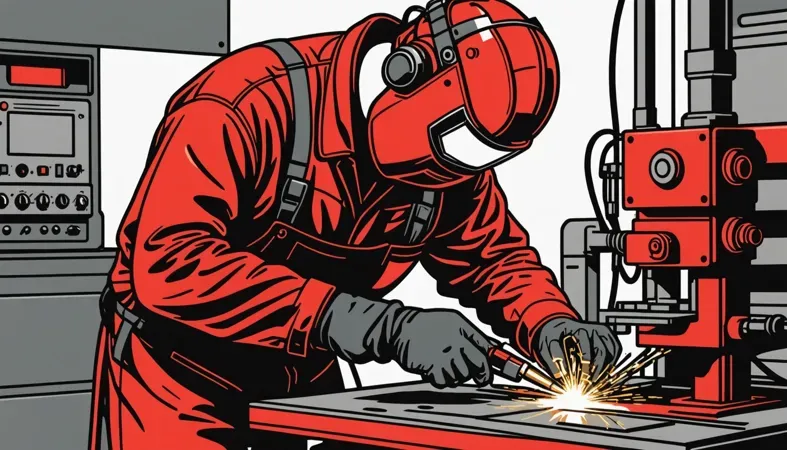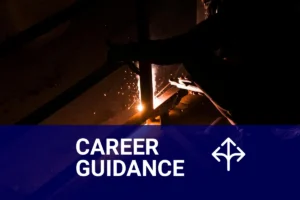What is the Job Outlook for a Welder? Trends, Types, Growth
Published on: February 20, 2025 | Last modified: March 4, 2025
By: Joe Carter
Job outlook refers to the expected demand and growth of jobs in a specific field over time. It’s crucial for job seekers to understand how many opportunities are available in their chosen careers.
I’m often asked about what is the job outlook for a welder? It’s important because this information helps you plan your future. From my experience, knowing the job outlook can keep you informed about industry trends and job security.
In this article, you’ll explore the job outlook for welders, learn how to assess it, discover factors affecting it, examine common issues welders face, and find tips for advanced job insight. We’ll also touch on different types of welding jobs and discuss how many welding jobs are available in the US.
Contents
- What is the Job Outlook for a Welder?
- How’s the Job Outlook for Welders?
- Types Of Job Outlooks
- Steps to Assess the Job Outlook for a Welder
- Factors Affecting the Job Outlook for Welders
- Understanding the Impact of Automation on Welder Job Outlook
- Common Issues for Welders in Their Job Outlook
- Typical Applications for Welders
- Exploring Alternatives to Assessing the Job Outlook for A Welder
- Frequently Asked Questions (FAQs)
- Conclusion
- References
What is the Job Outlook for a Welder?
The job outlook for welders is strong. According to the U.
S. Bureau of Labor Statistics, jobs in welding are projected to grow by 3% from 2021 to 2031. Industries like construction and manufacturing heavily rely on welding to build structures and engines. With ongoing infrastructure projects, demand for skilled welders will likely remain high.
How’s the Job Outlook for Welders?
The job outlook for welders indicates the demand for welding jobs over time. According to the U.
S. Bureau of Labor Statistics (BLS), employment for welders is projected to grow by about 3% from 2021 to 2031. This means around 43,000 new jobs in the U.
S. The steady need for skilled welders comes from various industries, including construction, manufacturing, and shipbuilding.
Welders are crucial (Essential) in fabricating, repairing, and constructing metal components. With the growth of renewable energy and infrastructure projects, more expertise is needed to meet industry demands. Jobs in specialized fields, such as robotic welding, are increasingly common.
To understand the job outlook for welders, monitor trends in construction and manufacturing. States like Texas and California have the highest number of welding jobs. In 2020, Texas had over 33,000 welders employed. Staying informed about available welding jobs can impact your career decisions.
Types Of Job Outlooks
-
Short-term Job Outlooks
Short-term job outlooks focus on immediate hiring within the next year. Many employers are increasing their efforts to fill welding positions, so you’ll find plenty of job openings. Check local job boards or join welding forums to stay updated on opportunities.
-
Long-term Job Outlooks
Long-term job outlooks project employment trends over the next decade. Employment for welders is expected to grow by about 8% from 2020 to 2030, indicating steady demand. Consider obtaining specific certifications, like AWS (American Welding Society), to stand out in the market. Proper technique is essential for every welding task, including understanding how to ground a welder.
-
Regional Job Outlooks
Regional job outlooks assess welding job availability in different areas. States like Texas and California have high demand, leading to more welding positions. To target these areas, explore state resources and local companies for job fairs and recruitment events.
-
Industry-specific Job Outlooks
Industry-specific job outlooks examine job demand in fields like construction and manufacturing. Sectors such as aerospace and automotive are particularly booming. Pursue internships or apprenticeships to gain experience and make connections in these industries.
-
Sector-based Job Outlooks
Sector-based job outlooks analyze the job market for specific sectors, such as energy or shipbuilding. For instance, shipbuilding welders experience constant demand due to ongoing naval contracts. Research companies in these sectors and attend job expos focused on skilled trades to get involved.
We have now covered the different types of job outlooks. Next, we will discuss how to assess the job outlook for a welder.
Steps to Assess the Job Outlook for a Welder
Here are the steps to evaluate current job trends for welders.
-
Research Current Job Market Trends
Start by checking online job platforms. Job boards like Indeed and Glassdoor show available welding positions. As of early 2023, there were over 50,000 welding jobs listed in the U.
S. Use this information to gauge demand in different regions and industries. Understanding the potential hazards of the profession is crucial, especially for specialized roles like underwater welders. Learn more about underwater welding dangers to better prepare for such career opportunities.
Check social media as well. LinkedIn groups and Facebook pages focused on welding often share job openings and insights. Engaging with these communities can provide a clearer picture of demand.
-
Identify Key Industries Hiring Welders
Focus on industries with the highest demand for welders. Sectors like construction, manufacturing, and transportation lead the way. The U.
S. Bureau of Labor Statistics cites fabrication shops and the automotive industry as top employers for welders. Note trends specific to your local area.
Network with professionals in these fields. Ask about hiring practices and valuable skill sets. Remember that sectors can vary widely; for example, industrial welding differs from ornamental metalwork.
-
Analyze Employment Projections
Examine projected growth rates for welding jobs. The U.
S. expects the welding sector to grow by approximately 3% from 2023 to 2033. States like Texas and California often show higher growth due to booming industries. Monitor trends like automation, as they affect job availability.
Use tools like ONET OnLine for specific data. You can find information on job openings, salary estimates, and required skills tailored to your state. A little research here can give you an advantage.
-
Network With Industry Professionals
Connect with welders and employers through industry events and trade shows. Gather firsthand insights about job openings and average salaries. You might discover hidden opportunities by talking directly to those in the field. I’ve learned my best tips from casual conversations at these events.
Don’t overlook online networking. Join forums or groups where professionals ask questions and share experiences. Reddit and Quora are great platforms for gaining insights through peer interaction.
-
Review Training and Certification Requirements
Investigate preferred training programs and certifications in your area. Consider the American Welding Society (AWS) for recognized certifications, as they can enhance your job prospects. Some sectors may require specific skills, like TIG or MIG welding.
Consider enrolling in local trade schools or community colleges offering welding programs. Hands-on experience is crucial. Recent figures show that welders with formal training can earn up to 20% more than those without.
Mastering various welding techniques is essential, especially when it comes to learning how to weld vertical.
We have now covered the steps to evaluate the job outlook for welders. Next, we will explore factors influencing this outlook.
Factors Affecting the Job Outlook for Welders
What factors shape the future of welding jobs in the industry?
-
Economic Growth
When the economy’s booming, construction ramps up, increasing demand for welders. For instance, a 2% GDP growth can boost welding job openings by 15% in sectors like manufacturing and construction.
-
Technological Advancements
New technology (Tech), like robotic welding, affects job availability. In 2020, over 50% of companies invested in automation, reducing some manual welding jobs while increasing demand for skilled technicians.
-
Regulatory Changes
Stay updated on safety regulations. Stricter health codes can create more inspection jobs for welders, altering job dynamics in various industries.
-
Skill Level and Training
Higher skill levels lead to better job prospects. According to the Bureau of Labor Statistics, about 70% of employers prefer welders with certifications, increasing vacancy rates for trained professionals. It’s also crucial to be aware of the health risks associated with the profession, including whether welding can cause cancer.
-
Geographical Location
Some states have a higher concentration of welding jobs. For instance, Texas leads with over 40,000 welding jobs, while states like Vermont have fewer, significantly affecting job outlook.
We’ve wrapped up the factors influencing the job outlook for welders here. Let us turn our attention to the effects of automation on this outlook.
Understanding the Impact of Automation on Welder Job Outlook
Automation is changing the landscape for welders in significant ways.
How Automation Affects Welding Jobs
- Increased Efficiency: Automated welding processes can complete jobs faster than manual methods. For instance, production lines using robotic welders see up to a 30% increase in output.
- Shift in Job Demand: While automation reduces the need for some manual welding positions, it creates demand for skilled technicians to operate and maintain automated systems. Positioned to grow, jobs for automation specialists in welding are expected to jump by 5% through 2031.
- Emergence of Hybrid Roles: The role of a welder is evolving. Today’s welders need to adapt and acquire programming skills to work alongside automated equipment. Statistics show that those familiar with both welding and robotics increase their employability by 40%.
Job Market Stats on Automation’s Impact
| Year | Robotic Adoption Rate (%) | Job Growth in Automation Roles (%) |
|---|---|---|
| 2021 | 15% | 3% |
| 2022 | 20% | 4% |
| 2023 | 25% | 5% |
| 2024 | 30% | 6% |
With the rise of automation, staying ahead means embracing new technologies. Having specialized knowledge can set you apart in a competitive market.
We covered the effects of automation on welder job prospects. We will now cover common challenges welders face in their job outlook.

Common Issues for Welders in Their Job Outlook
Now, let’s look at issues related to the job outlook for welders.
-
Job Market Competition
The job outlook often shows many qualified welders competing for positions. Identify high-demand areas by researching local businesses. Solve this by continuously upgrading skills and gaining certifications like AWS. Knowledge of safety is also critical as certain factors reveal what leads to electric shock in the welding field.
-
Workplace Safety Concerns
The job outlook considers safety records. Investigate injury rates by checking OSHA statistics. Improve safety with thorough training on personal protective equipment (PPE) and safe practices.
-
Access to Training Programs
The job outlook indicates how many entry-level roles exist. Training availability varies by region. Seek online courses or community college programs.
-
Workplace Equipment Costs
.
High-demand positions often require advanced tools. Identify needed equipment by reviewing job listings. Reduce costs by exploring leasing options or cooperative buying groups.
-
Industry Demand Fluctuations
.
The job outlook fluctuates based on manufacturing trends. Stay updated with industry reports from sources like the Bureau of Labor Statistics. Adjust marketing strategies to match demand cycles.
Typical Applications for Welders
Welding is used in heavy industries, but it has many unique applications, such as:
- Pipeline Construction: Welders join pipes for oil and gas transport. This ensures safe, leak-proof connections. Demand is high due to energy needs.
- Aerospace Manufacturing: Precision welding is crucial for aircraft components. It creates lightweight, strong structures that ensure safety and performance in flight.
- Shipbuilding: Welders create and repair hulls and interiors. It’s essential for making vessels sturdy against ocean conditions. Many naval yards rely on skilled welders to meet defense demands.
- Automotive Repair: Joining parts in auto shops is common. Welders fix frames and exhaust systems. Demand is constant as vehicles need regular maintenance and upgrades.

Exploring Alternatives to Assessing the Job Outlook for A Welder
You don’t have to rely only on traditional methods to gauge job prospects. Alternatives include utilizing job boards like Indeed and Glassdoor to see real-time listings for welding positions. For localized data, tools such as census.gov offer detailed statistics about regional demand.
After countless attempts and adjustments, I’ve figured out that engaging with industry groups, like the American Welding Society, can provide insights and networking opportunities. Also, attending trade shows focuses on automation and new tech in welding, giving you a fresh perspective on career options. These avenues can reveal opportunities that basic research might miss.
Frequently Asked Questions (FAQs)
Now let us look at some common questions I typically get asked.
How Many Welding Jobs Are Available?
There are about 450,000 welding jobs available in the United States. As of now, the Bureau of Labor Statistics predicts a 3% growth from 2021 to 2031. With over 14,000 new positions expected each year, you’ll find plenty of opportunities in a welding career.
For those entering the field, enhancing your visibility through improved welding techniques can be crucial; discover methods on seeing better when welding.
What State Has the Most Welding Jobs?
Texas has the most welding jobs compared to other states. The Lone Star State employs around 41,000 welders, making up about 9% of all US welding jobs. This high demand is due to its booming oil, gas, and construction industries.
What Are the Different Types Of Welding Jobs?
There are multiple types of welding jobs, including MIG, TIG, and Stick welding. MIG welding is popular for its speed and efficiency, while TIG welding offers precision. Each type requires specific skills and techniques, making the market diverse.
Are Welders Still in High Demand?
Yes, welders are still in high demand. Industries like construction and manufacturing require skilled welders for new projects. According to forecasts, the ongoing infrastructure developments will keep the demand steady for the next decade.
What is the Job Outlook for Welding?
The job outlook for welding remains positive. Several sectors rely on welding skills, ensuring a consistent need for workers. As technology advances, welders who can adapt will likely see even more opportunities.
Conclusion
We covered the job outlook for welders, discussing types of welding jobs, factors influencing employment, common challenges, and alternative assessments of job prospects. We also touched on how many welding jobs are available, what state has the most welding jobs, and typical applications welders work on. Overall, we explored the steps to assess the job outlook for a welder and frequently asked questions.
So, what is the job outlook for a welder? It’s strong, with a projected growth of 3% from 2021 to 2031 in the U.
S., which means about 40,000 openings annually. That covers those retiring and new job opportunities, so if you need additional advice, I’m here to help you navigate this field effectively.
For more insights into welding techniques and practices, visit What is Welding.
References
- Little, R. L. (1999). Welding and Welding Technology. New York, NY: McGraw-Hill Education.
- American Society of Mechanical Engineers. (2019). ASME Section IX: Welding and Brazing Qualifications. New York, NY: ASME.
Joe Carter is a retired welding professional with over 40 years of hands-on experience in the industry, spanning ship repair, structural welding, and even underwater projects. Joe is a master of MIG, TIG, and Stick welding. Passionate about mentoring the next generation of welders, Joe now shares his decades of expertise and practical insights to help others build rewarding careers in welding.
American Welding Society, Employment Growth, Job Outlook, Labor Statistics, MIG Welding, Personal Protective Equipment, Welder Demand, Welding, Welding Industry Trends, Welding Jobs, Welding Techniques







